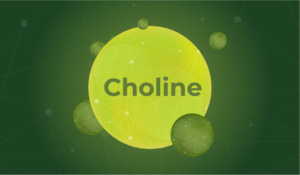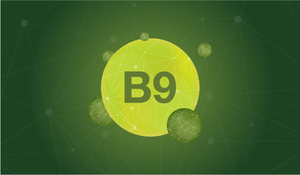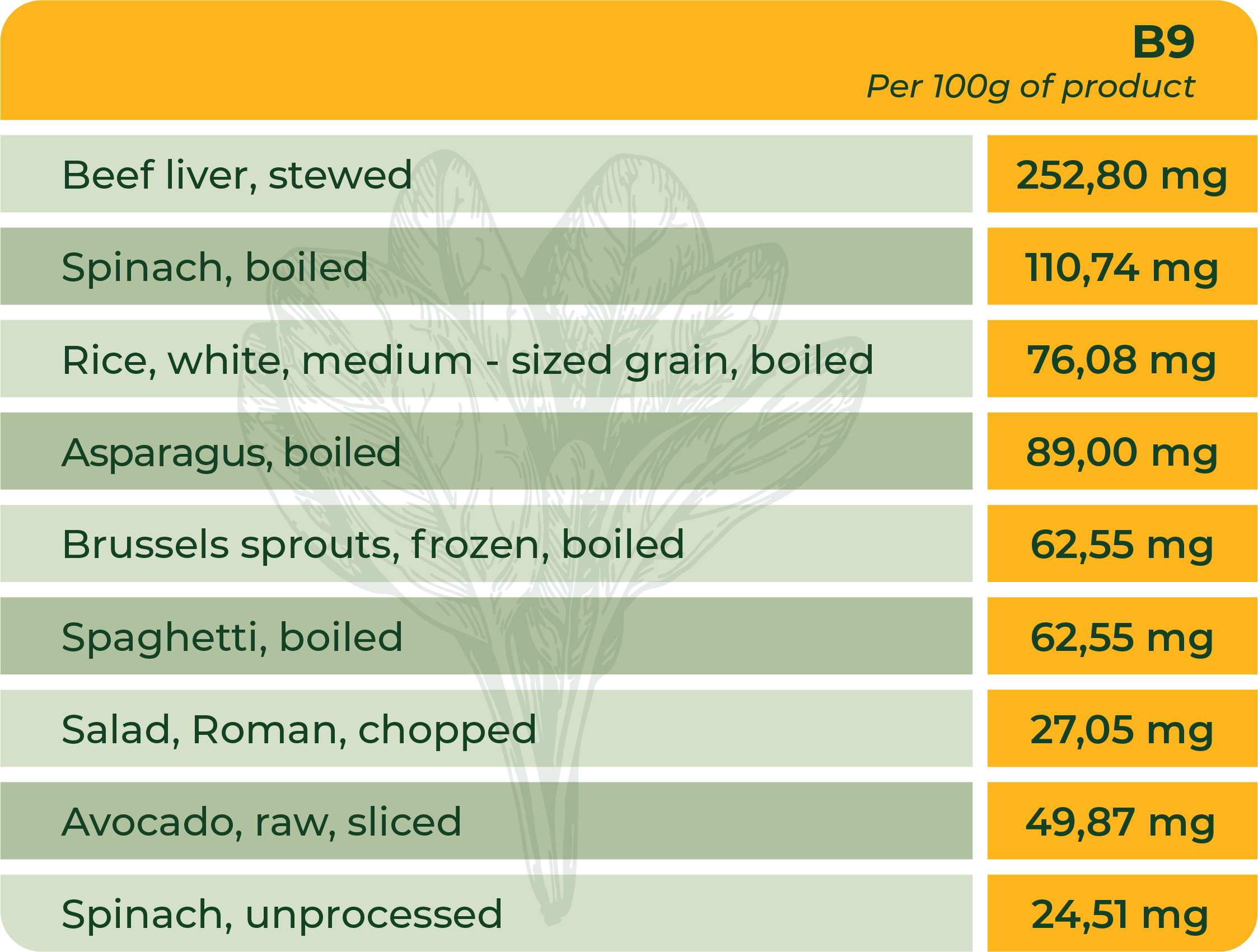
Choline
Choline, also known as vitamin B4, is a vital element for functioning of brain and nervous system. It is a component of neurotransmitters that drive communication among nerve cells. It has been found that subjects with sufficient choline intake have better memory and brighter mind. The body obtains majority of choline from diet and only a small amount of it can be produced by the liver.
Choline is nutrient similar to the B vitamins. It can be made in the liver. It is also found in foods such as meats, fish, nuts, beans, vegetables, and eggs.
Choline is a source of methyl groups needed for many steps in metabolism. The body needs choline to synthesize phosphatidylcholine and sphingomyelin, two major phospholipids vital for cell membranes. Therefore, all plant and animal cells need choline to preserve their structural integrity.
Choline plays an important part in many processes in the body, including:
- Cell structure: It is needed to make fats that support the structural integrity of cell membranes.
- Cell messaging: It is involved in the production of compounds that act as cell messengers.
- Lipid transport and metabolism: It plays an important role in synthesis of substances that are needed for transporting cholesterol away from the liver. Insufficient levels of choline will cause excessive lipid and cholesterol accumulation in the liver.
- DNA synthesis: Choline and other vitamins, such as B12 and folate, help with a process that’s important for DNA synthesis.
- A healthy nervous system: This nutrient is required to make acetylcholine, an important neurotransmitter. It’s involved in memory, muscle movement, regulating heart rhythm and other vital functions.
Humans can produce choline endogenously in the liver, mostly as phosphatidylcholine, but the amount that the body naturally synthesizes is not sufficient to meet human needs. The most common sources of choline in foods are the fat-soluble phospholipids phosphatidylcholine and sphingomyelin as well as the water-soluble compounds phosphocholine, glycerolphosphocholine, and free choline. When these choline-containing compounds are ingested, pancreatic and mucosal enzymes liberate free choline from about half of the fat-soluble forms and some water-soluble forms.
Citicoline is made up of two molecules: cytidine and choline. There is a view that citicoline multiplies a chemical vital for the brain – phosphatidylcholine. This chemical is important for brain functioning. Citicoline may also increase the amount of other chemicals that ensure communication within the brain.
Citicoline and its hydrolysis products (cytidine and choline) play an important role in phospholipid formation that are involved in building and restoring cellular membranes. It drives also important metabolic functions like nucleic acid protein and acetylcholine formation, where acetylcholine contributes to slowing down heart rate, dilation of peripheral blood vessels and lowering of arterial blood pressure, constriction of bronchi, increasing of peristalsis and secretory activity of the gastrointestinal tract. Acetylcholine contributes to memory improvement and counteracts adrenaline.
Choline deficiency can cause muscle damage, liver damage, and nonalcoholic fatty liver disease (NAFLD or hepatosteatosis). Choline deficiency in healthy, nonpregnant individuals is very rare, possibly because of the contribution of choline that the body synthesizes endogenously.
Although some people believe that vegetarians and vegans may be at risk of choline deficiencies, there is only mixed evidence to support this.
In fact, some of the foods with the highest choline content include soybeans, potatoes, and mushrooms. Eating a nutritious diet that focuses on whole foods should be enough to prevent deficiency.
Adults who are not found or established to be deficient in choline are normally required required 550 mg for men, 425 mg for women of choline per day.
Choline is not known to have any clinically relevant interactions with medications.
Stroke is a devastating neurological disorder and third most common cause of death. Usually stroke causes severe disability, high stroke recurrence risk and other unwanted outcomes. Lack or reduction of blood supply after the ischemic stroke causes internal deviation in functions of organs and systems that lead to damage of the nerve cells.
Underlying causes of neuron death both during ageing and progressing loss of neuron structure and functions both acute and chronic are one and the same. These are excessive accumulation of calcium ions and free radicals in the cell, oxidative stress (it appears if too many free radicals are created in the body that harm health and gradually speed up ageing), mitochondrial dysfunction and metabolic disorders that cause acidosis (acidosis reduces the contractility of heart muscle, causes vessel spasms, deteriorates oxygen supply to tissue. Acidosis also leads to breathing rhythm and consciousness disorders, deteriorates blood supply to the brain and kidneys). As a result, cellular signalling mechanisms that include interaction of thousands of diverse molecules through regulating processes from the membrane to the nucleus and back, are completely inhibited. Meanwhile, a cell that died can neither receive nor transmit nor store information, hence human cognitive (mental) functions undergo neurologic deficit.
Cytidine-5′-diphosphocholine (citicoline or CDP-choline), an intermediate in the biosynthesis of phosphatidylcholine, has shown beneficial effects in a number of CNS injury models including cerebral ischemia. Citicoline is composed of two molecules: cytidine and choline. Cytidine and choline separately pass through the BBB, enter brain cells, and act as substrates for intracellular synthesis of CDP-choline.
Citicoline may:
- decrease release of free fatty acids (excessive amounts of free fatty acids reduce insulin sensitivity or cause insulin resistance in tissue (in liver, heart, muscles and adipose tissue));
- restore mitochondrial adenosine triphosphate (ATF) (a nucleotide with very large impact on metabolism of living organisms and universal energy source for biochemical processes taking place in organisms);
- can be efficiently used in the brain cells for membrane lipid synthesis, where not only it increases phospholipid synthesis but also inhibits degradation of phospholipids;
- reduce or prevent impact of ischemia and/or hypoxia;
- reduce and restrict damage of neuron membranes, restore sensitivity and function of intracellular regulation enzymes and limit oedema;
- promote improvement of concentration, learning and memory performance.
Not only citicoline promotes synthesis of nucleic acid, protein, acetylcholine and other neurotransmitters (biologically active substances that are synthesized in a neuron and is discharged in a synapse; it binds to receptors of other cell and transmits nerve impulse from the synapse to cell), but also reduces formation of free radicals, confirming a view that citicoline at the same time inhibits various steps of ischemic cascades by safeguarding the injured tissues from early or delayed mechanisms that are related to ischemic brain damage. It must be mentioned that citicoline may promote recovery by contributing to synaptic growth and increase neuroplasticity, at the same time reducing neurological deficit and improving behaviour, ability to learn and memory function.
- Not all choline sources are made equally and as much as 50% of the choline we eat may be degraded by bacteria in the gut.
- Choline is not strictly a vitamin, but is an essential dietary amine. It is, however, known in the literature as vitamin B4.
- Choline hydroxide is known as choline base. It is hygroscopic and thus often encountered as a colorless viscous hydrated syrup that smells of trimethylamine (TMA). Aqueous solutions of choline are stable, but the compound slowly breaks down to ethylene glycol, polyethylene glycols, and TMA
- In 1849, Adolph Strecker was the first to isolate choline from pig bile. In 1852, L. Babo and M. Hirschbrunn extracted choline from white mustard seeds and named it sinkaline. In 1862, Strecker repeated his experiment with pig and ox bile, calling the substance choline for the first time after the Greek word for bile, chole, and identifying it with the chemical formula C5H13NO. In 1850, Theodore Nicolas Gobley extracted from the brains and roe of carps a substance he named lecithin after the Greek word for egg yolk, lekithos, showing in 1874 that it was a mixture of phosphatidylcholines.
- In the early 1930s, Charles Best and colleagues noted that fatty liver in rats on a special diet and diabetic dogs could be prevented by feeding them lecithin, proving in 1932 that choline in lecithin was solely responsible for this preventive effect.

Gotu Kola (Centella asiatica L.)
Gotu Kola is a perennial plant, very common in tropic and sub-tropic areas around the globe. People in Asia believe that Gotu Kola can extend one's longevity. In Ayurvedic medicine it is an efficient supporter and promoter of neuron and brain cell activity. Gotu Kola is one of commonly used plants after a stroke. It is included in plant pharmacopoeia of India and Great Britain.
Gotu Kola is a perennial plant native to India, Japan, China, Indonesia, South Africa, Sri Lanka, and the South Pacific. A member of the Apiaceae or carrot family, it has no taste or smell. It is also called pennywort, marsh penny, water pennywort, and sheep rot.
It thrives in and around water. It has small fan-shaped green leaves with white or light purple-to-pink flowers, and small oval fruit. The leaves and stems of the Gotu Kola plant are used as medicine. It can grow like a weed, but its description depends on its location. For example, in shallow water, the leaves float; but in dry areas, the plant develops many roots and thin, tiny leaves. The fan-shaped leaves may be smooth or lobed. Red flowers turn into fruit with a diameter of about 5 mm.
Gotu Kola's main active components are triterpenoids, although the Gotu Kola found in India, Sri Lanka, and Madagascar doesn't have the same properties. Gotu Kola's triterpenes can have a concentration from 1.1-8%, with most concentrations in the middle range.
The plant enhances brain and peripheral circulation, and is said to enhance memory. In the 1880s, the French began using Gotu Kola as part of regular pharmaceutical medicines.
Gotu Kola is typically safe to consume. However, some reported side effects of the herb include: drowsiness, nausea, headaches, dizziness, diarrhea, skin irritation.
Although there is limited research on Gotu Kola’s effect on other medications, it’s possible that it can interfere with prescription or over-the-counter medications. Always consult your doctor before using Gotu Kola.
Stroke can cause cognitive decline. The frequency of cognitive impairment after an ischemic stroke ranges from 20 to 30%, with an increasing risk in the two years after stroke. In their research, Ballard et al. found that 25% of patients suffered from poststroke dementia, and the risk of poststroke patients developing dementia within the following five years is nine times higher than in the healthy population, especially for cognitive domains such as memory and attention. Management of cognitive impairment following cerebrovascular disease should be aimed at the prevention of secondary strokes and specific treatment for the improvement of cognitive function. Secondary stroke prevention includes control of risk factors such as blood pressure, cholesterol levels, and hyperhomocysteinemia.
One medicinal herb commonly used is Gotu Kola (Centella asiatica). The main group of components in Gotu Kola is the triterpenes including asiaticoside, madecassoside, asiatic acid, and madecassic acid, which have antioxidant, anti-inflammatory, and antiapoptotic properties. This may explain why Gotu Kola has a positive influence on brain plasticity, as well as in increasing the length of dendrites and an enhancement of hippocampal CA3 neuronal dendritic arborization in mice inflicted with neurodegenerative diseases and memory disorders.
Study aimed to determine the improvement of cognitive function in patients with vascular cognitive impairment utilizing the Montreal Cognitive Assessment-Indonesian version (MoCA-Ina) after an intake of Gotu Kola (Centella asiatica) 750 mg/day and 1000 mg/day and of folic acid 3 mg/day for 6 weeks.
- Historically, Gotu Kola has also been used to treat syphilis, hepatitis, stomach ulcers, mental fatigue, epilepsy, diarrhea, fever, and asthma.
- The name sheep rot comes from the erroneous belief in Europe that Gotu Kola caused foot rot in sheep.
- Gotu Kola is noted in India as a very powerful spiritual herb, and Ayurvedic medicine refers to it as Brahmi because it helps obtain knowledge of the spiritual being.
- Chinese herbalist, Li Ching Yun, is supposed to have lived 256 years from drinking a herbal mixture containing Gotu Kola. An ancient Sinhalese saying, "Two leaves a day will keep old age away," also illustrates Gotu Kola's popularity as an agent for longevity.

Vitamin B9 or folic acid
A water-soluble vitamin necessary for human immune system, cardiovascular and haematopoietic systems. Human body is not able to synthesize folic acid therefore it relies on dietary uptake. Supplementing with this vitamin lowers plasma concentration of homocysteine which in turn reduces the risk of cardiovascular disease.
Vitamin B9, also called folate or folic acid, is one of 8 B vitamins. All B vitamins help the body convert food (carbohydrates) into fuel (glucose), which is used to produce energy. These B vitamins, often referred to as B-complex vitamins, also help the body use fats and protein. B-complex vitamins are needed for a healthy liver, and healthy skin, hair, and eyes. They also help the nervous system function properly. Folic acid is the synthetic form of B9, found in supplements and fortified foods, while folate occurs naturally in foods.
All the B vitamins are water-soluble, meaning the body does not store them except for B12 which is stored in liver and used whenever required. Folic acid is crucial for proper brain function and plays an important role in mental and emotional health. It aids in the production of DNA and RNA, the body's genetic material, and is especially important when cells and tissues are growing rapidly, such as in infancy, adolescence, and pregnancy.
One of the most important folate-dependent reactions is the conversion of homocysteine to methionine in the synthesis of S-adenosyl-methionine, an important methyl donor. Another folate-dependent reaction, the methylation of deoxyuridylate to thymidylate in the formation of DNA, is required for proper cell division. An impairment of this reaction initiates a process that can lead to megaloblastic anemia, one of the hallmarks of folate deficiency.
Isolated folate deficiency is uncommon; folate deficiency usually coexists with other nutrient deficiencies because of its strong association with poor diet, alcoholism, and malabsorptive disorders. Megaloblastic anemia, which is characterized by large, abnormally nucleated erythrocytes, is the primary clinical sign of folate or vitamin B12 deficiency. Its symptoms include weakness, fatigue, difficulty concentrating, irritability, headache, heart palpitations, and shortness of breath.
Folate deficiency can also produce soreness in and shallow ulcerations on the tongue and oral mucosa; changes in skin, hair, or fingernail pigmentation; gastrointestinal symptoms; and elevated blood concentrations of homocysteine.
Folate deficiency is rare, but some individuals might have marginal folate status. People with alcohol use disorder frequently have poor-quality diets that contain insufficient amounts of folate. Moreover, alcohol interferes with folate absorption and hepatic uptake, accelerates folate breakdown, and increases its renal excretion
Adults who are not found or established to be deficient in Vitamin B9 are normally required 400 mg (600 mg for pregnant women) of Vitamin B9 per day.
Folate supplements can interact with several medications. A few examples are provided below. Individuals taking these medications on a regular basis should discuss their folate intakes with their healthcare providers.
Methotrexate
Methotrexate (Rheumatrex®, Trexall®), used to treat cancer and autoimmune diseases, is a folate antagonist. Patients taking methotrexate for cancer should consult their oncologist before taking folate supplements because the supplements could interfere with methotrexate’s anticancer effects. However, folate supplements might reduce the gastrointestinal side effects of low-dose methotrexate taken for rheumatoid arthritis or psoriasis.
Antiepileptic medications
Antiepileptic medications, such as phenytoin (Dilantin®), carbamazepine (Carbatrol®, Equetro®, Epitol®), and valproate (Depacon®), are used to treat epilepsy, psychiatric diseases, and other medical conditions. These medications can reduce serum folate levels. Furthermore, folate supplements might reduce serum levels of these medications, so patients taking antiepileptic drugs should check with their healthcare provider before taking folate supplements.
Sulfasalazine
Sulfasalazine (Azulfidine®) is used primarily to treat ulcerative colitis. It inhibits the intestinal absorption of folate and can cause folate deficiency. Patients taking sulfasalazine should ask their healthcare provider whether they should increase their dietary folate intake, start taking a folate supplement, or both.
An elevated homocysteine level has been associated with an increased risk of cardiovascular disease. Folate and other B vitamins are involved in homocysteine metabolism, and researchers have hypothesized that these micronutrients reduce cardiovascular disease risk by lowering homocysteine levels.
Folic acid (and vitamin B12) supplements lower homocysteine levels. However, these supplements do not actually decrease the risk of cardiovascular disease, although they appear to provide protection from stroke.
- Folate and its role in human biochemical functioning was first identified by researcher Lucy Wills in 1931. She found that the nutrient was needed to prevent anemia during pregnancy.
- Folic acid is so important to human health, it is included in many types of foods, especially breakfast cereal. The process to add a vitamin to other foods is called fortification. So, a cereal that has added vitamins is called fortified.
- Folic acid is named from a latin word (folium) which means leaf. This comes from the fact that leafy vegetables are very rich in folic acid.
- Lack of folic acid can also cause a decrease in the amount of red blood cells in the body. This condition is called anemia. The type of anemia caused by folic acid deficiency is called a macrocytic anemia. Macrocytic means "large cells." So, lack of folic acid causes low levels of red blood cells, and the individual red blood cells are really large.
- Folic acid is actually better absorbed by the body than natural folate, almost twice as efficiently.
 Free delivery to Omniva parcels throughout the Baltics for purchases from 20 euros!
Free delivery to Omniva parcels throughout the Baltics for purchases from 20 euros!


